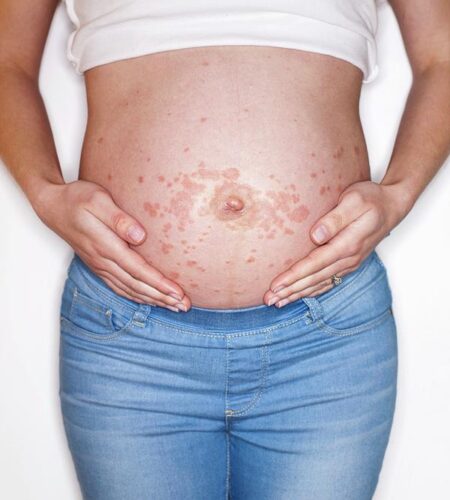Pregnancy is a transformative journey, but it can also bring about unexpected changes in your body, including the development of skin rashes. While many women experience the famed “pregnancy glow,” others may find themselves dealing with skin-related challenges. Rashes during pregnancy are relatively common and can vary in type and severity. In this comprehensive guide, we’ll explore the causes of rashes during pregnancy, their symptoms, and provide practical tips for managing and alleviating discomfort while ensuring the safety of both you and your baby.
Table of Contents
Common Causes of Rashes During Pregnancy

Rashes can develop during pregnancy for various reasons, including hormonal changes, immune system alterations, and increased blood flow. Here are some common causes:
1. Pruritic Urticarial Papules and Plaques of Pregnancy (PUPPP):
PUPPP is one of the most common pregnancy-related rashes. It typically occurs in the third trimester and presents as itchy, raised, and red bumps or plaques on the abdomen, often spreading to other areas of the body.
2. Prurigo of Pregnancy:
This rash consists of small, itchy bumps that can appear on the arms, legs, and abdomen. It usually occurs in the second or third trimester.
3. Pemphigoid Gestationis:
Also known as herpes gestationis, this rare autoimmune skin disorder can cause blistering and intense itching. It often starts in the abdomen and spreads to other areas.
4. Atopic Eruption of Pregnancy:
This condition typically affects women with a history of atopic dermatitis (eczema). It can cause itchy, red, and scaly patches of skin.
5. Pruritic Folliculitis of Pregnancy:
This rash is characterized by itchy pimple-like bumps that can appear on the arms, legs, and buttocks.
6. Contact Dermatitis:
Pregnant women may develop contact dermatitis if they come into contact with allergens or irritants. This rash can manifest as redness, itching, and swelling.
7. Heat Rash:
Increased blood flow during pregnancy can lead to heat rash, especially in hot and humid climates. Heat rash presents as small, itchy bumps and often occurs in areas prone to sweating.
8. Stretch Marks:
While not a traditional rash, stretch marks are common during pregnancy. They appear as red or purple streaks on the abdomen, breasts, and thighs due to the stretching of the skin.

Symptoms of Pregnancy-Related Rashes
The symptoms of pregnancy-related rashes can vary depending on the type and severity of the rash. Common symptoms include:
- Itching (pruritus)
- Redness (erythema)
- Bumps or raised areas on the skin
- Swelling (edema)
- Blistering or vesicles (in some cases)
- Scaling or flaking of the skin
It’s important to note that some rashes can be accompanied by other symptoms, such as fever, fatigue, or joint pain. If you experience any unusual or severe symptoms, it’s crucial to consult your healthcare provider promptly.
Managing and Alleviating Rashes During Pregnancy
Managing pregnancy-related rashes requires a combination of self-care measures and medical guidance. Here are practical tips to help alleviate discomfort and manage these rashes effectively:
1. Maintain Good Hygiene:
- Keep the affected area clean and dry to prevent further irritation and infection.
2. Avoid Hot Water:
- Use lukewarm water for bathing and washing the affected area. Hot water can worsen itching and dry out the skin.
3. Use Gentle Cleansers:

- Choose mild, fragrance-free cleansers that won’t strip the skin of its natural oils.
4. Moisturize Regularly:
- Apply a hypoallergenic and fragrance-free moisturizer to the affected area to help soothe dryness and itching.
5. Wear Loose-Fitting Clothing:
- Opt for loose, breathable fabrics like cotton to minimize friction and irritation. Avoid tight-fitting clothing.
6. Avoid Scratching:
- Scratching can exacerbate itching and potentially lead to infection or scarring. Use cold compresses or over-the-counter anti-itch creams (after consulting your healthcare provider) to relieve itching.
7. Stay Cool:
- Overheating can worsen rashes. Try to stay in a cool and well-ventilated environment.
8. Oatmeal Baths:
- Soaking in an oatmeal bath can provide relief for itchy skin. You can find oatmeal bath products at most drugstores.
9. Consult Your Healthcare Provider:
- If the rash is severe, persistent, or accompanied by other symptoms, consult your healthcare provider. They can determine the cause of the rash and recommend appropriate treatment options.
10. Medications (if necessary):
- In some cases, your healthcare provider may prescribe topical or oral medications to manage severe or persistent rashes. These medications will be chosen with consideration of their safety during pregnancy.
11. Identify Triggers:
- If you suspect a specific allergen or irritant is causing the rash (e.g., a skincare product or fabric), discontinue use and consult your healthcare provider for alternative options.
When to Seek Medical Attention

While most pregnancy-related rashes are benign and resolve on their own or with self-care measures, there are situations where medical attention is essential. You should seek prompt medical care if you experience:
- Severe itching that does not respond to over-the-counter remedies
- Blisters or open sores
- Fever or flu-like symptoms
- Joint pain
- Generalized swelling
- Difficulty breathing or any signs of a severe allergic reaction
Conclusion: Navigating Pregnancy-Related Rashes with Care
Pregnancy-related rashes, while often uncomfortable, are a common occurrence during this transformative journey. By understanding the causes, recognizing the symptoms, and following appropriate management strategies, you can alleviate discomfort and ensure the health and well-being of both you and your baby. Remember that every pregnancy is unique, and it’s essential to consult your healthcare provider for personalized guidance and treatment options if you experience persistent or severe rashes. With proper care and attention, you can embrace the beauty of pregnancy while managing and alleviating rashes effectively.




Comments